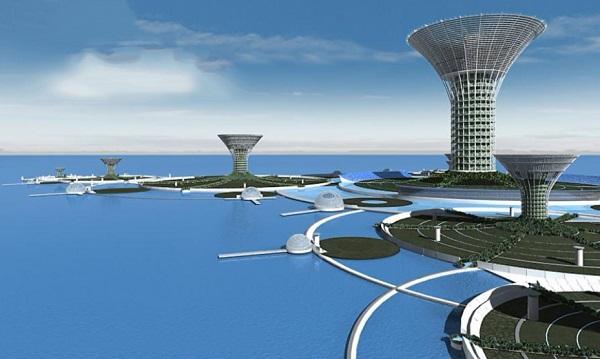
How Shimizu Corporation plans to give Singapore more space by the sea
Its floating city project, Green Float, can house up to 50,000 people.
With only so much land to go around, space-starved Singapore is looking at floating homes as a possibility to ease its crippling land shortage. Japan-headquartered engineering firm Shimizu Corporation thinks that more space can be unlocked by the waters as it tests its floating city model in various markets— including Singapore.
Dubbed Green Float, the floating city project is expected to be able to withstand natural disasters such as typhoons and tsunamis and could stand for 100 years.
The man-made island will be 3 kilometres in diameter, featuring a 1,000 metre tall skyscraper city. A “city in the sky” will be located on the upper 300 metres and the lower levels will be used to house natural farms and shops. The middle levels are designated for plant factories, whilst the upper levels will hold residential areas that can house 30,000 to 50,000 people.

Photo credit: Shimizu Corporation
“The land area [in Singapore] is never large, and this is a major issue for future growth of the country. By using underground or sea, it is possible to realise ‘Land Unlimited,’” Masaki Takeuchi, the project leader of Green Float told Singapore Business Review, in reference to a popular documentary on Singapore’s land problem.
With only 721.5 sqkm in land area and a population that’s expected to grow to 6.9 million by 2030, Singapore has been aggressively exploring options to unlock more land, foremost of which is its Draft Masterplan 2019 which aims to free up over 1,000 hectares of land for property development.
According to Takeuchi, Green Float offers two types of floating city, which would depend on the needs of a country. One would function simply as a city extended to the sea, becoming a place for commercial use, hotels and housing. The other type will house plants, warehouses and factories from the mainland and will be set up either inside or around the floating city. Commercial and housing areas will then be developed on mainland after their relocation.
The city would rely on methods such as space solar power satellites, ocean thermal energy conversion and carbon dioxide capture and storage, making it self-sufficient and carbon-free, according to Green Float. To ensure food self sufficiency, waste can also be used to grow food on vertical vegetable factories in the city’s lower levels which lends support to the government’s goal of producing a third of its nutritional needs by 2030.

Photo credit: Shimizu Corporation
The floating city is to be placed at the equator line which would reportedly insulate the city from destructive typhoons, hurricanes and typhoons.
Furthermore, there are no landfilling procedures involved in the building of Green Float. A number of large cities have also reached the limit of landfill expansion and Takeuchi adds that landfilling could cost more than building a floating city. This allows its properties to have not much of a price difference as compared to those on land.
“Because Singapore is near the equator, both the waves and the winds are calm. Also, Floating City is more environmental-friendly than landfilling, and there is no need to export a large amount of sand from other countries,” he explained.
Construction still hasn’t started as the team is still in the midst of verification and testing phase of a starting model, but Takeuchi stated that he wishes to launch by 2030. The Green Float II project was certified by a third party organisation Class NK (Nippon Kaiji Kyokai) in 2017 which found the firm’s mobile offshore drilling units and special purpose barges compliant.
However, he noted that what’s mostly challenging them in every targeted market are its existing regulations.
In Singapore, a Floating City can only last a hundred years— as it must still comply with its 99-year leasing policy for residential property developments that has been in force since 1967. The firm confessed that the model has capabilities to last for more than that.
“The mega float city is no exception,” Takeuchi stated. “Consensus-making of urban planning and rational and efficient methods of construction will also gradually progress in the future. The speed of progress may be slower than the speed of technology development.”
By Nathanielle Punay
























 Advertise
Advertise









